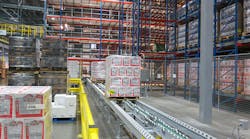Retailers are on the move.
To become more efficient and serve customers more quickly, retailers are moving the various parts of their distribution functions under one roof. To do this companies are willing to either build onto existing locations or even build new locations to achieve the cost savings that centralized locations can offer.
“Retailers are now looking for economies of scale,” explained Eric Lamphier, senior director - Product Management at Manhattan Associates on the sideline of the MODEX show currently underway in Atlanta. “They are bringing all channels into a single facility to both track inventory and provide fulfillment services.”
For the past decade as retailers built up their eCommerce business they relied on 3PLs to handle several functions, Lamphier said. Efforts were on connecting the back end to store inventory and the focus was on creating the necessary IT infrastructure to manage this. Now the next step is to unify the channels under one roof.
“Retailers were carrying duplicate and triplicate inventory, which is very costly,” said Lamphier. Moving inventory to one central location is less expensive. The driver behind this, of course, is the large volume of eCommerce business and its particular demands. Retailers now must carry a larger assortment of products online as compared to what they had to carry in brick and mortar stores. While the number of products has gone up the orders themselves have become smaller.
And perhaps the most important factor for this change is the new level of customer expectations. “Part of the rush to create single, integrated spaces is to deliver on the two-day delivery expectation that Amazon created," Lamphier added. "Retailers feel the need to meet this new customer expectation."
Automation
Automation in the distribution center is also a way to increase efficiency but retailers are being very careful as to how much they are willing to invest. Bringing in robots is expensive, and the robots can be rigid in their abilities.
“An important consideration to investing in robotics is the issues of return on investment," Lamphier said. "Sometimes it can take five to ten years to see a profit from the investment made in robots; compare that number to the two to five-year ROI on hardware and software, and you see the dilemma companies are in.”
The solution is that companies are doing pilot programs in specific warehouses to find where the robots will be most useful.
Looking for increased efficiency is an on-going exercise for distribution centers and Lamphier says that companies like his are working hand in hand with companies to find the most efficient solutions.











